Uber Eats E-Bike Riders: Best Food Delivery Apps and Smart Setup for 2025
Riding an Uber Eats e-bike has quickly become the go-to move for food couriers in cities like Toronto, New York, and Vancouver. Electric bikes aren’t just a trend; they’re a smart solution that makes food delivery faster, easier, and less tiring. Over the past few years, top apps like Uber Eats, Skip, and DoorDash have started to support e-bike riders with special perks, bonus zones, and flexible rental plans, all designed for the realities of city life.
But which delivery platform truly gives riders the edge? Most gig workers see better earnings and less downtime when they match the right app with a dependable e-bike built for delivery services. In this guide, I’ll share what actually works on busy streets, highlight the best platforms for e-bike riders in 2025, and show how your gear—like a rugged, long-range e-bike—can make or break your shift. If you're considering an upgrade, take a look at the professional delivery eBike product page for features that stand up to daily delivery use. The right choices can help you boost earnings and stay comfortable on every ride.
Why More Riders Are Using E-Bikes for Food Delivery
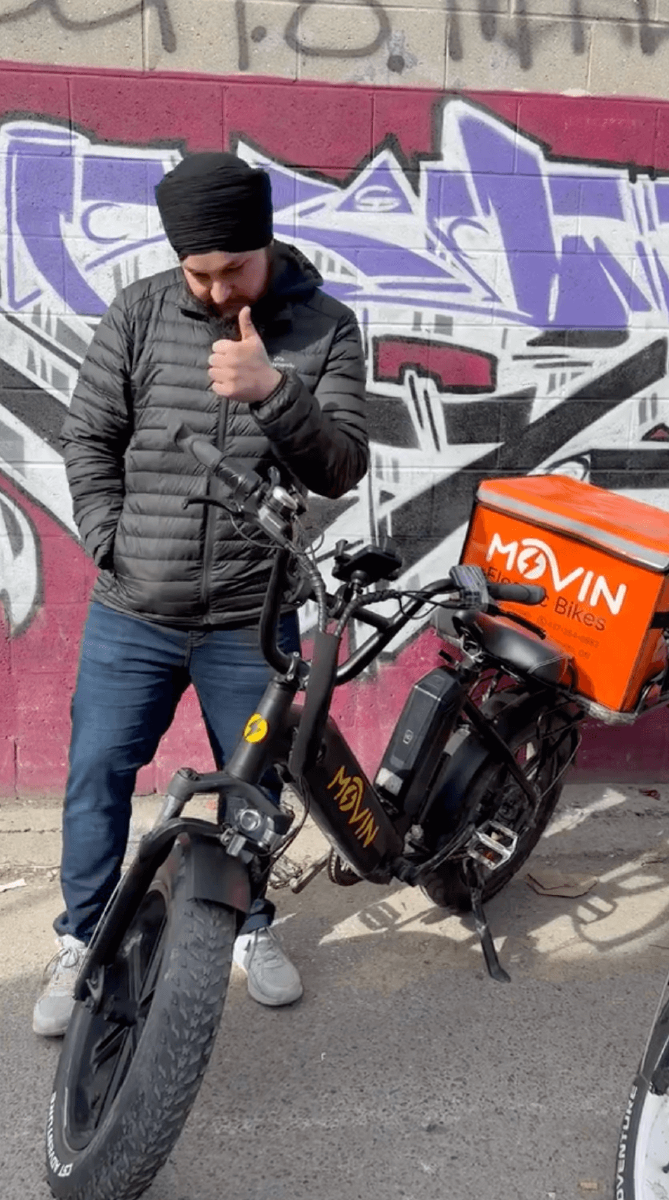 The surge in Uber Eats e-bike riders across big cities is no accident. E-bikes have rewritten the rules for food delivery, providing riders what cars, scooters, and traditional bikes simply can't match. I see more couriers making the switch because of practical speed gains, real cost savings, a smoother daily grind, and greener streets. Let’s get into why food delivery pros are picking e-bikes more than ever.
The surge in Uber Eats e-bike riders across big cities is no accident. E-bikes have rewritten the rules for food delivery, providing riders what cars, scooters, and traditional bikes simply can't match. I see more couriers making the switch because of practical speed gains, real cost savings, a smoother daily grind, and greener streets. Let’s get into why food delivery pros are picking e-bikes more than ever.
Faster Deliveries in Urban Traffic
Time matters when delivering hot food. E-bikes slice through traffic and sneak down bike lanes, helping couriers avoid red lights, gridlocked streets, and the endless hunt for parking. Most riders report up to a 30% cut in delivery times compared to cars or mopeds. With a pedal-assist system, I can keep my pace high even after hours on the road, making every shift more productive.
Improved Earnings Through Savings and Efficiency
Hourly pay means little if your costs eat up the gains. E-bikes shine here. They run on electricity, not expensive gas, and routine maintenance is much lighter—no oil changes, emissions tests, or major breakdowns. These savings add up:
- No gas expenses: A full month’s worth of charging barely equals a single tank of fuel.
- Lower repairs: Fewer moving parts and no engine to service.
- Longer range per charge: Models designed for food delivery, especially with dual batteries, can cover whole evenings’ worth of orders.
All this lets couriers keep more of their delivery income while taking on more trips each shift. For a deeper dive into city-specific benefits, check out food delivery e-bikes in Toronto.
Higher Ratings and Happier Customers
Speed alone improves delivery ratings. Hot food stays hot, and customers are less likely to complain about long waits. Riders with e-bikes often earn more five-star reviews, which unlocks bonus zones and priority orders on apps like Uber Eats. This virtuous cycle lets top riders pick better gigs, boost their weekly take-home, and stand out on every platform.
Cleaner, Greener Deliveries
There’s a visible shift towards sustainability. E-bikes run quietly and produce zero tailpipe emissions, helping cities cut noise and pollution while meeting strict environmental rules. Most riders like knowing they’re doing their part, and many customers prefer platforms supporting cleaner delivery options.
All-Weather Performance and Durability
Canadian riders battle rain, snow, and salt all winter. That’s why the right e-bike for food delivery needs true durability. I recommend looking at options with wide, grippy tires, weather-sealed electronics, and sturdy cargo racks. Models like the Pulse Fat Tire Delivery E-Bike are built to survive icy commutes and long, cold nights—giving riders the confidence to keep working no matter the forecast.
For more information about e-bike models built for demanding Canadian conditions, see these insights on delivery riders using e-bikes in Canada.
The Bottom Line: Why E-Bikes Win for Food Delivery
Food delivery riders want advantages that add up in dollars, comfort, and customer feedback. E-bikes check every box: faster routes, lower costs, greener travel, and bikes sturdy enough for any season. That’s why 2025 will see even more Uber Eats e-bike riders picking up shifts and powering cities meal by meal.
Which Food Delivery Apps Are Best for E-Bike Riders in 2025?
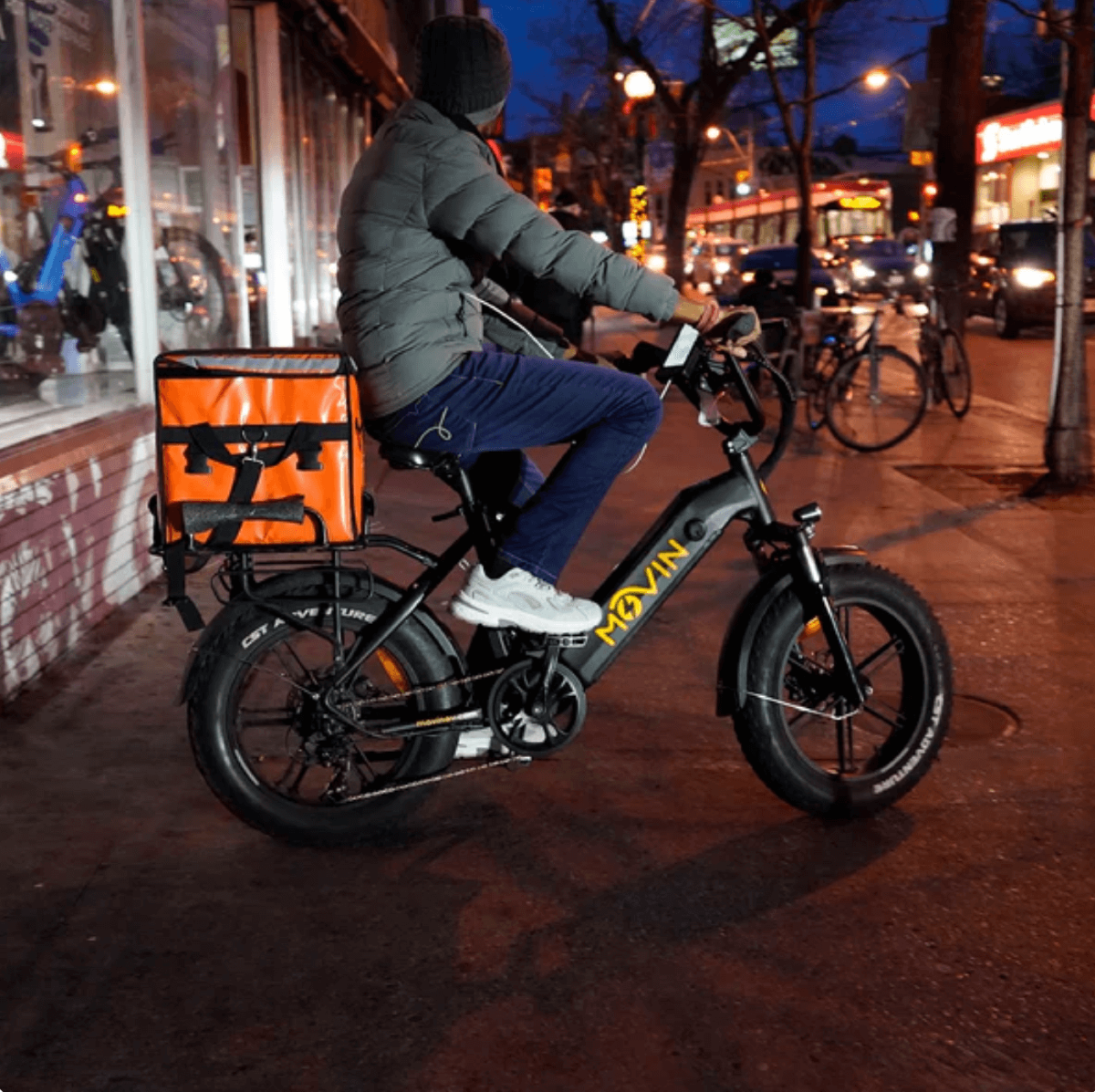 Choosing the right delivery app can completely change your daily earning power as a food courier. With food delivery now a cornerstone of city life, knowing how major platforms like Uber Eats, DoorDash, Grubhub, and others support e-bike riders is key. Each app brings its own mix of pay, flexibility, equipment requirements, and bike-friendliness. The best choice often comes down to where you ride, how many orders you want to fill, and which features help you stay safe and productive on two wheels.
Choosing the right delivery app can completely change your daily earning power as a food courier. With food delivery now a cornerstone of city life, knowing how major platforms like Uber Eats, DoorDash, Grubhub, and others support e-bike riders is key. Each app brings its own mix of pay, flexibility, equipment requirements, and bike-friendliness. The best choice often comes down to where you ride, how many orders you want to fill, and which features help you stay safe and productive on two wheels.
Uber Eats E-Bike: Why It Stands Out
Uber Eats is the standout food delivery app for e-bike riders in 2025. It checks all the big boxes that matter for couriers who want efficient shifts and steady income.
- Flexible Shifts: Uber Eats lets me log in and out whenever I like. That means no strict scheduling—just pick up jobs as they pop up, ideal for those juggling other commitments or peak-hour work.
- Massive Customer Base: With more people using Uber Eats in cities across North America, I see a steady flow of delivery requests from morning to late night.
- Frequent Deliveries & Hotspots: The app optimizes for dense, short-range routes that play perfectly to the strengths of an e-bike. I can bounce between restaurants and customers without backtracking miles, keeping my hourly income high.
- Official E-Bike Support: Uber Eats encourages e-bike use with a dedicated option in the app. It takes minutes to add your bike as a delivery method, and verification is straightforward—usually just ID and basic info.
- Partner Discounts: Couriers get access to partner deals. I’ve used discounts from e-bike rental companies like Zoomo, which means I can rent or own a reliable e-bike without a huge upfront cost. Maintenance offers and discounted accessories help lower my gear expenses.
- Smart Navigation and Rider Tools: The Uber Eats app isn’t just a delivery queue. It highlights busy zones, maps safe cycling routes, and sends safety alerts. During winter or late-night deliveries, in-app prompts remind me to check lights or wear visible gear.
These features help me stay productive, safe, and comfortable—especially when using a delivery-ready e-bike made for rough urban streets. If you’re curious about how e-bikes transform the delivery game in Canada’s cities, take a look at this delivery e-bike guide for Canada.
 ### Comparing DoorDash, Grubhub, and Others for E-Bike Delivery
### Comparing DoorDash, Grubhub, and Others for E-Bike Delivery
Uber Eats may be king, but plenty of riders mix apps or switch to boost earnings. Here’s how the other major platforms stack up when it comes to supporting e-bike delivery:
DoorDash
- E-Bike and Bike Modes: DoorDash allows couriers to sign up with a bicycle or e-bike in most urban markets. Adding your e-bike only takes a quick profile update, though approval can take a day or two.
- Flexible Zones: I see good delivery density in most cities, but DoorDash zones can be stricter than Uber Eats—you may need to reposition between neighborhoods to find steady work.
- Bonuses and Peak Pay: DoorDash often hands out bonus payments during busy dinner or weekend hours and offers “Challenges” that pay cash for completing extra trips.
- Insurance & Safety Rules: DoorDash recommends but doesn’t require specific insurance for e-bike riders. Some cities have local rules about safety gear and registration, so always check before rolling out.
- Limitations: DoorDash sometimes restricts e-bike use in lower-density suburbs or areas with fewer restaurants. Always verify which zones are bike-friendly.
Grubhub
- Bike Mode (Selective Markets): Grubhub’s bike delivery is available in select cities only, and some markets prefer car couriers.
- Scheduling: Shifts are scheduled in advance on Grubhub. This makes planning easier, but you can’t always jump on instantly during slow periods.
- Earnings Flexibility: Payouts tend to be consistent, and Grubhub sometimes sends repeat deliveries to the same address, which helps on multi-stop runs.
- Insurance/Requirements: Rules match DoorDash—not much in the way of enforced insurance, but be ready for market-specific gear rules.
Instacart and Grocery Alternatives
- Grocery Delivery Focus: Instacart also lets riders deliver by bike in several cities. Most gigs are grocery runs, so trips are longer with heavier loads—a real test for your e-bike’s cargo racks and battery.
- Mixed Support: Not all cities offer Instacart bike delivery yet, so check availability.
Quick Comparison Table
AppE-Bike SupportSchedulingBonus/Promo PayRegistration/InsuranceUber EatsYes (dedicated)On-demandFrequent, busy timesCity-dependentDoorDashYes (most cities)On-demandChallenges, Peak PayCity-dependentGrubhubSome citiesPre-scheduledPromo pay variesCity-dependentInstacartSome citiesShiftsLess frequentUsually not required
Key Takeaways:
- Uber Eats e-bike mode stays the most accessible and flexible by far.
- DoorDash offers good earnings but can limit e-bike use in less dense parts of the city.
- Grubhub’s coverage for bikes and e-bikes is patchy, but worth stacking on busy weekends if your market allows it.
- Instacart and grocery options are niche, mainly suited for riders with bikes built for bigger loads.
With these choices, most e-bike riders find Uber Eats leads for flexibility, steady work, and support features, while DoorDash makes a solid backup for heavy-hitting shifts. If you want more on optimizing delivery shifts and choosing a bike that can handle Canada’s seasons, check out this Canada delivery e-bike overview for couriers.
How to Choose the Best E-Bike for Food Delivery Apps
 Picking the right e-bike can change your daily food delivery grind, letting you ride longer, carry more, and dodge breakdowns. Not all e-bikes are up to the challenge of rough city roads and back-to-back Uber Eats shifts, so knowing what to look for makes a real difference. Here's how I sort out which e-bike is built to survive—and even thrive—on app-based food delivery routes.
Picking the right e-bike can change your daily food delivery grind, letting you ride longer, carry more, and dodge breakdowns. Not all e-bikes are up to the challenge of rough city roads and back-to-back Uber Eats shifts, so knowing what to look for makes a real difference. Here's how I sort out which e-bike is built to survive—and even thrive—on app-based food delivery routes.
Battery Life and Range Matter Most
Long battery life is king when you’re riding for apps like Uber Eats. Look for a bike with a high-capacity battery, ideally 15Ah or more, and dual-battery options if you’re tackling marathon shifts or hilly neighborhoods. More range means you don’t have to waste time on midday recharging or worry about running out of juice before the dinner rush.
- Pro tip: Delivery e-bikes like the Movin Pulse are made for extended range and can go all evening, even in colder weather when batteries drain faster.
- For route planning in specific cities and seasons, the Best delivery e-bikes for Canada guide is packed with insights.
Powerful Motor for Urban Terrain
A strong motor helps blast up hills and carry heavier loads without breaking a sweat. For city riding, a motor of at least 500W is a smart choice. This helps with quick starts at traffic lights and keeps your pace up, even when the app sends you up steep downtown blocks.
- Why it matters: Weak motors make you slower, tired, and less competitive for quick turnarounds on fast food pickups.
Durable Design for Everyday Use
City streets mean potholes, salt, and curbs. You want a tough frame, wide tires for traction, and a suspension system that smooths the ride. Some of the best bikes for Uber Eats e-bike work use heavy-duty components and have weather-sealed electronics to shrug off rain and winter mess.
- Top delivery bikes often include fat tires and reinforced cargo racks.
- Sturdy e-bikes last longer and hold up when dropped or bumped during fast deliveries.
For a comparison of bike features for Canadian delivery work, see this Canada-specific e-bike for food delivery breakdown.
Comfort for Long Shifts
Hours in the saddle get rough if your bike isn’t comfortable. Look for adjustable handlebars, an ergonomic seat, and good suspension. These details matter when you’re on your second or third dinner rush and still have plenty of orders to go.
What makes a bike comfortable for delivery?
- Upright riding position (saves your back and neck)
- Smooth suspension for cracked roads and curb drops
- Padded saddle and grips
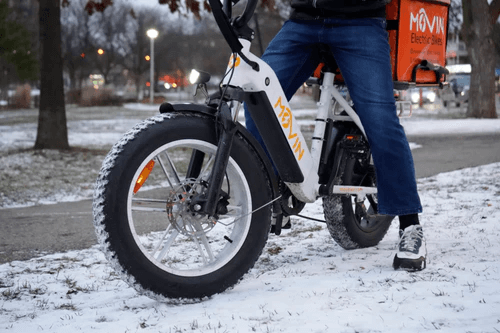 ### Cargo Space and Secure Racks
### Cargo Space and Secure Racks
A solid rear rack or basket is crucial for food delivery. Many apps, including Uber Eats, favor riders who can handle family-size orders, pizza bags, or groceries. Make sure the bike you choose can handle insulated delivery totes and has tie-down points, not just a bare rack.
- Some professional e-bikes have integrated racks or bolt-on setups that hold up under daily strain.
For Toronto-specific tips (folding bikes, cargo choices, winter packing), there’s a handy section in the Canadian guide to delivery e-bikes.
Maintenance and Support
A low-maintenance e-bike with local support can keep you earning without annoying downtime. Features like puncture-resistant tires, sealed drivetrains, and quick-release batteries add up to fewer repairs and less lost work.
- Access to parts and reliable warranty service is key, especially for delivery pros using their e-bike every day.
- For quick fixes, learn the basics of e-bike care from the Ultimate E-Bike Repair & Maintenance Guide.
Quick Checklist: What a Food Delivery E-Bike Should Have
Here’s what I always check before committing to a delivery-ready e-bike:
- Battery: 15Ah+ (dual batteries are a bonus)
- Motor: 500W or higher
- Frame: Tough, with weatherproofing
- Suspension: Front or full suspension for comfort
- Tires: Wide, grippy, puncture-resistant
- Cargo: Sturdy racks for food bags
- Comfort: Adjustable seat/handlebar, upright style
- Maintenance: Easy-to-replace parts, service backup
Choosing the right e-bike isn’t just about spec sheets. It’s about finding a workhorse that helps you ride more, earn more, and stay comfortable and safe year-round—especially while working for popular food delivery apps like Uber Eats.
Tips for Maximizing Earnings and Efficiency as an E-Bike Delivery Rider
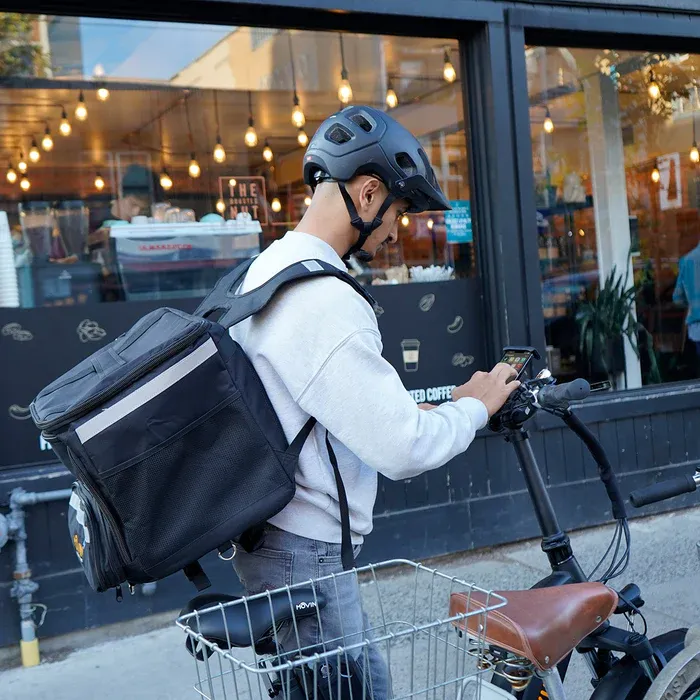 Delivering food on an Uber Eats e-bike can be rewarding and efficient, but only if you treat it like a real business. Smart riders know small decisions stack up to bigger earnings—from when you log on to how you maintain your bike. Let me share practical advice that will help both new and seasoned couriers make the most out of every shift and stay comfortable on long runs.
Delivering food on an Uber Eats e-bike can be rewarding and efficient, but only if you treat it like a real business. Smart riders know small decisions stack up to bigger earnings—from when you log on to how you maintain your bike. Let me share practical advice that will help both new and seasoned couriers make the most out of every shift and stay comfortable on long runs.
Schedule Smart: Target High-Paying Times
Making the most of your hours means working smarter, not just harder. Focus on:
- Peak Hours: Lunch (11 am–2 pm) and dinner (5 pm–9 pm) bring a flood of orders. Apps often pay extra during these rush periods.
- Friday and Weekend Nights: Demand spikes with late-night cravings and special deals—these are prime money-making windows.
- Weather Edge: When rain or snow hits, fewer riders take to the streets. Step up then, and you’ll net more orders with less competition and often higher bonuses.
Setting a clear weekly goal and tracking which days or neighborhoods pay best helps you avoid burnout and work at your own pace.
Use Bonuses, Incentives, and Tips to Boost Pay
Every extra dollar counts when delivering on an e-bike. Most food delivery apps offer:
- Boosted Zones: Uber Eats “Quest” and DoorDash challenges pay cash for reaching order targets.
- Stacked Orders: Accepting combined deliveries when they’re going in the same direction increases your hourly average.
- Customer Tips: Prompt, polite delivery and texting updates before arriving help unlock higher tips with little extra effort.
I always check in-app promotions before heading out, planning my shifts around the latest bonus hotspots.
Optimize Your Routes and Waiting Spots
Where you wait in the city can make or break your income. Riders who get to know their local neighborhoods move quicker between jobs and avoid dead time. My top advice:
- Park Near Restaurant Clusters: Busy intersections lined with popular food spots see more activity and faster pickup times.
- Use Route Apps: Tools like Google Maps or the in-app navigation help find bike-friendly routes, avoid traffic jams, and ensure you stay in delivery zones. Shortest isn’t always fastest—sometimes bike lanes make the trip quicker even if it's a longer route.
- Beat the Red Lights: Learning side streets and common shortcut paths helps shave minutes off each delivery.
-
Map Out Rest Spots: Know where you can safely rest, recharge, or access a washroom during longer shifts.
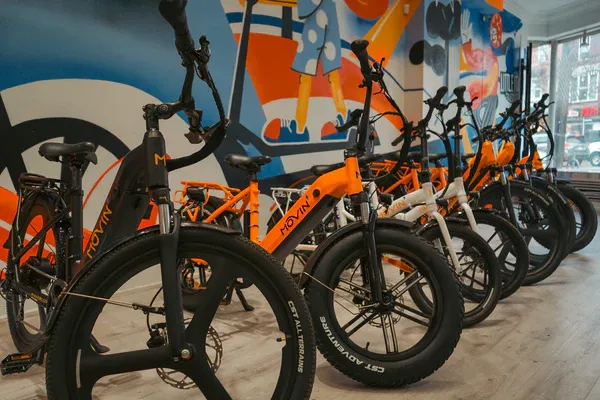
Keep Your E-Bike Running Like New
Reliable equipment is the foundation of steady delivery work. Riders doing 30 to 100 kilometers a day need bikes built to withstand the grind. I recommend:
- Daily Inspections: Check tire pressure, brakes, lights, and battery connections before each shift.
- Weather Readiness: Lube your chain often in winter and after rainy rides, and dry off exposed connectors to prevent rust. Delivery e-bikes designed for Canada cope much better with snow and salt.
- Charge Routine: Keep a reliable charging habit. Plug in after every ride, and if you have a dual-battery setup, carry a spare for peace of mind on long hauls.
- Quick Repairs: Know how to patch a tire or swap out a broken part. Solid e-bikes are made for easy fixes—take a look at the e-bike connector overview if you need advice on connectors or quick electrical maintenance.
Stay Comfortable and Safe for Long Shifts
Riding day after day takes a toll if you don’t look after yourself. To keep up both comfort and safety:
- Invest in Gear: Weatherproof gloves, layered clothing, and a high-quality helmet go a long way. Reflective strips or a bright jacket make a difference in low light.
- Hydrate and Snack: Courier work is active. Carry water and easy snacks, and take short breaks to recharge.
- Tune Your Setup: An upright seat, proper handlebar height, and a good delivery bag not only help you stay comfortable but also reduce fatigue over long shifts.
An efficient Uber Eats e-bike setup isn’t just about speed; it’s about keeping you sharp, happy, and earning more every week. Treat your delivery routine like a craft, and the rewards line up shift after shift.
Conclusion
Pairing an Uber Eats e-bike with the right delivery apps is the smart move for anyone who wants to maximize earnings, ride in comfort, and keep shifts running smoothly. Reliability and real-world durability are game changers when working long hours in city traffic and rough weather. Everything comes down to choosing solid equipment and trusted support, backed by the experience of other busy delivery pros.
If you want a bike that stands up to the grind, take a closer look at the professional delivery eBike product page. The investment can pay off every day you’re out there. Thanks for following along, and if you’ve got delivery stories or tips for using a Uber Eats e-bike, I’d love to hear from you. Stay tuned for more practical guides and real rider insights that make urban food delivery work for you.
